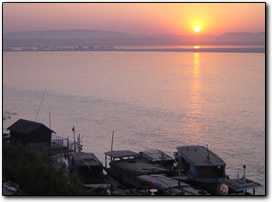
Mandalay
Back in the lowlands on the Ayeyarwady River, we stopped to linger in the imperial city of Mandalay for a few days. The city is laid out in a rectangular grid of streets around the immense former royal palace. The palace is surrounded by a moat that measures more than a mile on a side. Nearby Mandalay hill, a popular sunset stroll, is covered with pagodas and temples. At the base of the hill are several important temples.
Mandalay is an industrious town or small workshops. One neighborhood specializes in the production of gold leaf. Gold is placed between sheets of special bamboo paper, then pounded by hand with heavy mallets for hours until it becomes very thin. The sheets are hammered and cut several times until they become as thin as possible. For the hard, physical effort of hammering the gold, laborers are paid less than a dollar a day for their ten hours of work. Once the sheets of gold leaf are thin enough, ladies sitting in enclosed rooms cut them into squares and package them for sale in the temples. Arriving by bike, we wandered around the area, following the sounds of pounding, until we discovered a small, family-run outfit away from the main tourist whistle-stop. Peeking shyly into the compound, the family that ran the small operation welcomed us in, and one of the sons, practicing his English, showed us around and explained the process.
 |
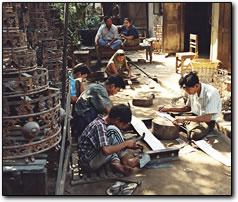 |
One morning we visited the jade and gem market. The entire process of making jade, from the raw rocks through the cutting and polishing to the appraising was on display. Buyers picked over rough stones, peering at them intently or holding them to the light for evaluation. One man rubbed a cut and polished rock on his cheek to “feel” its value. As the only tourists, we were soon surrounded by hawkers offering polished jade and gems. They discreetly pulled out small packets of paper to unwrap precious-looking stones or offered pellets of bright green jade in their opened palms for appraisal. We waved them off and continued further into the bowels of the market. Rows of cutters sliced the low-quality impurities from raw jade rocks. Polishers worked foot-powered grinding stones, rolling rough fragments of jade over the spinning surface. Small pieces were glued to long sticks for the final polishing on rolling trunks of bamboo. Further along, men sat at tables with the finished pieces of jade laid out into neatly arrangements by size and color. Here we asked about the values of the different stones, attracting another small crowd of onlookers as one of the men tried to explain which of the stones were more valuable than the others. To us, apart from size they all looked alike. A man walked up to us with a stack of “tickets” and asked us to pay an entrance fee to see the market. We waved him away and continued our tour. At the rear was an area where women appraised jade bracelets. One matronly-looking woman had attracted quite a crowd. Each bundle of bracelets, wrapped in newspaper, was carefully opened and the bracelets removed. One by one she rolled them over her hands, studied them at different angles in the light and peered at them with a keen eye before naming a price. Usually the seller would slink off with a disappointed air after hearing her pass judgment on his wares. The persistent jade hawkers followed us to the exit where we had parked our bicycles, their prices constantly dropping along the way. Finally, as we turned to leave, we bought a piece of jade as a souvenir for the equivalent of fifty cents.
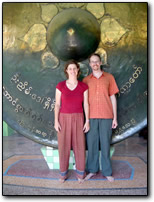 |
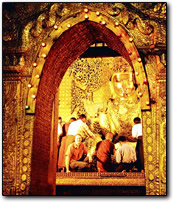 |
Mahamuni, the most revered Buddha image in Myanmar, has its own temple in another part of town. The passageway that leads to the Buddha is lined with shops selling bells, ornaments and other temple decorations and paraphernalia. This bronze Buddha, so covered with gold leaf that its hand appear to be wearing giant ski gloves, sits in a gilded niche at the center of the temple. Around the neck of the Buddha are gold chains and amulets of glittering precious stones. Men are allowed to approach to statue, but the women must resign themselves to sit in prayer in the outer sanctum or to watch the Buddha on live, closed-circuit TV. Outside, in the temple courtyard, was a giant, 3m-diameter gong. As we wandered around, a man climbed up to raised platform and started beating an enormous drum. Around Mahamuni was an entire neighborhood devoted to temple-related industries. Carvers busied themselves cutting and polishing marble Buddhas. Stone tables were inscribed in looping Burmese script. Cottage-scale outfits manufactured “hti”, or temple umbrellas, an important ornament so prevalent in Myanmar, with its many stone chedi. Now we knew where all the decorations came from!
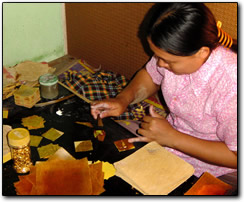 |
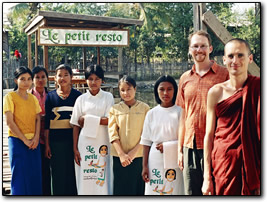 |
Later that evening we rode to the opposite end of town, passing the immense fortress moat, to Mandalay hill. Leaving our bikes at the bottom, we huffed our way up the endless chain of stairs leading to the summit. Near the top we were approached by monks who wanted to practice their English. They immediately asked us what we though of the situating in Myanmar. We were surprised that the monks could be so forthright and open about the political situation. We talked with them as we climbed the rest of the way to the top of the hill where we enjoyed the sunset together. They desperately wanted to practice their English and were eager to talk about Buddhism and monastic life. After sunset they took us to the Kuthodaw or “holy book” monastery, where an entire Pali Buddhist triptych, written on stone tablets, was housed in 729 stone pagodas.
A small flyer in our guesthouse advertised “le petit resto” (the little restaurant) in a monastic school to the east of the city. Intrigued, we decided to visit. Here we met Dhamma, a Swiss monk who had been living in Burma for the last seven years. “Le petit resto” was an idea of a French friend of his to teach some of the schoolchildren how to run a small bistro. Dhamma lived and taught at the school. One of his specialties was teaching html and web design to the children at the school.
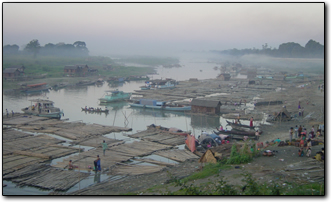 |
